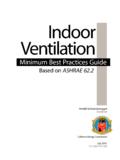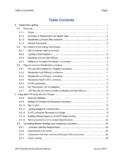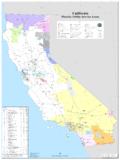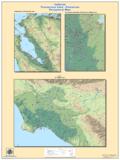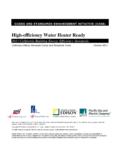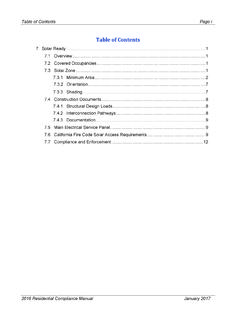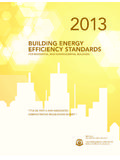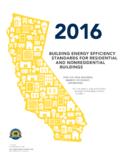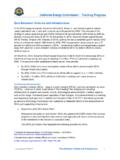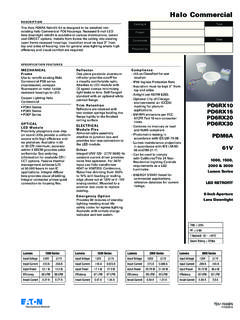Transcription of CALIFORNIA ENERGY COMMISSION
1 Residential Lighting JA8 Compliance For Test Laboratories 2016 Building ENERGY Efficiency Standards What is the scope of the 2016 Joint Appendix JA8? The 2016 Building ENERGY Efficiency Standards ( ENERGY Standards) Joint Appendix JA8 was updated to make it technology neutral with regard to light sources. Previously, this appendix was only applicable to LED luminaires. The changes allow for both lamps and luminaires to be considered high efficacy under the ENERGY Standards regardless of the lighting technology employed. How does this affect testing under JA8? JA8 now specifies a test for efficacy and color characteristics that is specific to each lighting technology. The test for LEDs remains Illuminating Engineering Society (IES) LM-79, and the tests for other lighting technologies are the applicable IES test procedures or the applicable federal test (per and ).
2 JA8 also specifies tests for start time, power factor, lumen maintenance and survival rate, audible noise, and flicker, which are the same for all light sources. When should I test the luminaire, and when should I test the lamp or light engine? If the light source can be easily separated from the luminaire by the end user, such as a removable screw-base or pin-base lamp, or a detachable LED light engine, then the light source must be tested separately from the luminaire. If the light source is inseparable from the luminaire, then the entire luminaire must be tested. Inseparable means that the light source cannot be easily removed or replaced by the end user. This includes cases where wiring would need to be cut or reattached, where solder would need to be removed or reapplied, or where attempting to remove the light source could potentially damage the luminaire. How do I determine how many models to test?
3 Manufacturers must test each basic model of the products they intend to certify. Both state and federal appliance efficiency laws use a definition of basic model to determine when separate testing is needed. The ENERGY Standards defer to these definitions to be consistent with federal law and with its references to the Title 20 Appliance Efficiency Regulations. The definition of basic model in Title 20 reads as follows: CALIFORNIA ENERGY COMMISSION Basic model of a federally regulated consumer product means basic model as defined in 10 section Basic model of any other appliance means all units of a given type of appliance (or class thereof) that are manufactured by one manufacturer, that have the same primary ENERGY source, and that do not have any differing electrical, hydraulic, physical, or functional characteristics that affect ENERGY consumption.
4 The following guidance regarding color temperature and color rendering also applies to lighting, and may reduce the number of models required to be tested: Correlated Color TemperatureTesting at the lowest or least efficient correlated color temperature (CCT) is acceptable forcompliance with JA8, provided that the change is only due to a variation in phosphor. Whilea change in phosphor can affect the lumens-per-watt efficacy of a light source, this effect issmall, predictable, and has consistently decreased as lighting technology has are advised to test the warmest or otherwise worst performing CCT within amodel family. This is consistent with ENERGY STAR guidelines and ensures that off-the-shelf testing of models perform equal to or better than their certified values. Color Rendering IndexTesting at the highest color rendering index (CRI) is acceptable for compliance with requires that light sources possess a CRI of 90 or above and an R9 of 50 or CRI is expressly noted in the federal basic model definition, the limited range ofallowed performance will generally mean that only one model from a model family or groupwill perform in this range, and any solely CRI-based differences between models within thisrange are expected to have a negligible impact on efficiency.
5 Manufacturers are thereforeadvised to test the highest CRI model within a model family. This ensures that off-the-shelftesting of models perform equal to or better than their certified I use the ENERGY STAR Family Groupings (for luminaires) or Allowable Variations (for lamps) to determine which models to test? Yes. The ENERGY STAR guidance lists specific elements of a lamp or luminaire that can be changed without affecting the performance of the unit. Following the ENERGY STAR guidance will result in selection of the same models as following the basic model definition in all but a few rare cases. Thus, laboratories are advised that they may follow this guidance, but should also keep in mind the basic model definitions in case of a conflict. My client s products include several inseparable luminaires that make use of a common, dedicated LED array for their light output.
6 Does mean that each luminaire needs to be separately tested, even though they use the same array? No. If each luminaire is designed to use the same dedicated light engine or array, and to provide the same physical and thermal conditions necessary for the performance of its engine or array, then the luminaires would not have differing characteristics that affect its performance (regardless of differences in shape or aesthetics) and only one basic model would need to be tested. A model with a different size or number of arrays would need a separate test, as this would affect its ENERGY consumption. If a light source is tested with a third-party driver, and a customer requests an equivalent, alternative driver, can the same test results apply without a complete re-test? Yes. The test results can continue to apply provided that the rated performance of the alternate driver is at least as good as the tested driver.
7 This ensures that off-the-shelf testing of models perform equal to or better than its certified values. Is a sample group needed for the start time, flicker, and audible noise tests? No. The sample size requirement in applies to the tests that rely on a sample group. The tests for start time, flicker, and audible noise are tests performed on a single unit, not on a sample group, and repeat performance of these tests is not required. Does the Power Factor test need to be conducted at the highest wattage? Yes. The power factor test must be conducted at full light output, which means the model will be operating at its highest wattage. If a product uses a universal driver, do I need to conduct the Power Factor test at multiple voltages? No. A universal driver is a driver with one large voltage range, not a driver with multiple separate ranges. The additional testing required by ANSI 2002 Section 6 only applies when a product has multiple ( , more than one) voltage ranges.
8 Where can I find more information? The 2016 Building ENERGY Efficiency Standards and Reference Appendices can be downloaded at Copies of JA8 and JA10 are included with this fact sheet. Certification of product data will be to the Modernized Appliance Efficiency Database System (MAEDBS database), the same system used for certifying regulated appliances under Title 20. Certification will be available for JA8 2016 in early October, 2016, and more information will be available at Who can I contact if I have any questions? For assistance with the 2016 Building ENERGY Efficiency Standards, contact the ENERGY Standards Hotline at (800) 772-3300 (toll free in CALIFORNIA ), (916) 654-5106 (outside CALIFORNIA ), or via email at For assistance with the appliances certification process and the MAEDBS database, contact the Appliance Efficiency Hotline at (888) 838-1467 (toll free in CALIFORNIA ), (916) 651-7100 (outside CALIFORNIA ), or via email at CEC-400-2016-018-FS2016 Joint Appendices Appendix JA8-1 Joint Appendix JA8 Appendix JA8 Qualification Requirements for High Efficacy Light Sources Purpose and Scope Joint Appendix JA8 provides the qualification requirements for high efficacy light sources installed to comply with Section (k).
9 For the purposes of this Section, high efficacy light sources include ballasts or drivers if needed for operation of the light source: light sources shall be certified together with a driver or ballast. If the light source is inseparable from the luminaire the entire luminaire shall meet the requirements of this section. All qualifying light sources shall be certified to the ENERGY COMMISSION according to all of the requirements in this Appendix. Certification of Test Labs The light source under test shall be tested at a testing laboratory participating in the ISO/IEC 17025, by the National Voluntary Laboratory Accreditation Program (NVLAP) or other laboratory accreditation body operating in accordance with ISO/IEC 17011 and produced under an ongoing inspection program carried out by a Type A inspection body in accordance with ISO/IEC 17020. JA Tests to be performed Compliance with the requirements of this Appendix shall be determined by performance of the following test procedures, as applicable to the type of light source.
10 Sample size for lamps with ANSI standard bases and that are not recessed downlight retrofits, shall be 10 units per model: 5 units tested base-up and 5 units tested base-down unless the manufacturer restricts specific use or position. If position is restricted, all units shall be tested in restricted position. Test units, including low voltage lamps, shall be operated at rated voltage. Sample size for all other sources shall be 3 units, tested in accordance with manufacturer s installation instructions for intended orientation. JA Efficacy Test Efficacy at full light output shall be determined by the following test procedures, as applicable to the type of light source: a) For incandescent and incandescent reflector lamps: 10 CFR (r). b) For medium base compact fluorescent lamps: 10 CFR (w). c) For general service fluorescent lamps: 10 CFR (r). d) For fluorescent lamps that are not Medium base compact fluorescent lamps and general service fluorescent lamps: IES LM-9.
